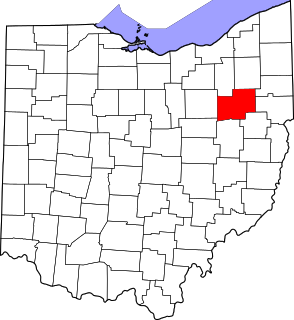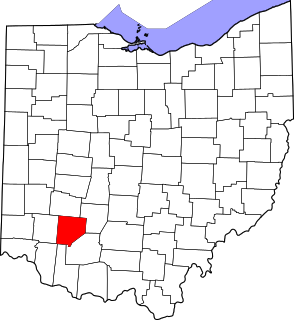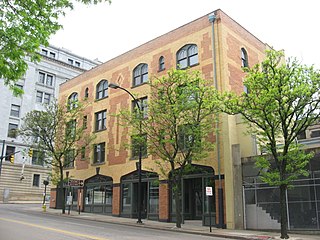
Summit County is an urban county in the U.S. state of Ohio. As of the 2020 census, the population was 540,428, making it the fourth-most populous county in Ohio. Its county seat is Akron. The county was formed on March 3, 1840, from portions of Medina, Portage and Stark Counties. It was named Summit County because the highest elevation on the Ohio and Erie Canal is located in the county.

Bath Township is one of the nine townships of Summit County, Ohio, United States. The 2000 census found 9,635 people in the township, a suburb of Akron.

This is a list of properties and districts in Ohio that are listed on the National Register of Historic Places. There are over 4.000 in total. Of these, 73 are National Historic Landmarks. There are listings in each of Ohio's 88 counties.

The Goodyear Airdock is a construction and storage airship hangar in Akron, Ohio. At its completion in 1929, it was the largest building in the world without interior supports.

The Old Market is a neighborhood located in downtown Omaha, Nebraska, United States, and is bordered by South 10th Street to the east, 13th Street to the west, Farnam Street to the north and Jackson Street to the South. The neighborhood has many restaurants, art galleries and upscale shopping. The area retains its brick paved streets from the turn of the 20th century, horse-drawn carriages, and covered sidewalks in some areas. It is not uncommon to see a variety of street performers, artists, and other vendors.

This is a list of the National Register of Historic Places listings in Cuyahoga County, Ohio.

This is a list of the National Register of Historic Places listings in Summit County, Ohio.

The South Omaha Main Street Historic District is located along South 24th Street between M and O Streets in South Omaha, Nebraska. It was added to the National Register of Historic Places in 1989. Home to dozens of historically important buildings, including the Packer's National Bank Building, the historic district includes 129 acres (0.52 km2) and more than 32 buildings.

The Lower Main Street Historic District is a historic district comprising the first several blocks of Main Street in Beacon, east of its intersection with South Street, the end of its concurrency with NY 9D. The District covers about 50 acres and includes 32 buildings, most of them in the late 19th-century Italianate style.

The Stevensville Historic District, also known as Historic Stevensville, is a national historic district in downtown Stevensville, Queen Anne's County, Maryland. It contains roughly 100 historic structures, and is listed on the National Register of Historic Places. It is located primarily along East Main Street, a portion of Love Point Road, and a former section of Cockey Lane.

This is a list of the National Register of Historic Places listings in Stark County, Ohio.

The Carlton House Block is a historic commercial and retail block at 9-13 Hampden Street in Springfield, Massachusetts. Built in 1873, and updated in the early 20th century, it is a good example of Italianate architecture, built during the downtown's development as an industrial and commercial center. The building was listed on the National Register of Historic Places in 1983.

The Monroe Avenue Commercial Buildings, also known as the Monroe Block, is a historic district located along a block-and-a-half stretch at 16-118 Monroe Avenue in Detroit, Michigan, just off Woodward Avenue at the northern end of Campus Martius. The district was designated a Michigan State Historic Site in 1974 and listed on the National Register of Historic Places in 1975. The thirteen original buildings were built between 1852 and 1911 and ranged from two to five stories in height. The National Theatre, built in 1911, is the oldest surviving theatre in Detroit, a part of the city's original theatre district of the late 19th century, and the sole surviving structure from the original Monroe Avenue Commercial Buildings historic period.

The Lower Woodward Avenue Historic District, also known as Merchant's Row, is a mixed-use retail, commercial, and residential district in downtown Detroit, Michigan, located between Campus Martius Park and Grand Circus Park Historic District at 1201 through 1449 Woodward Avenue and 1400 through 1456 Woodward Avenue. The district was listed on the National Register of Historic Places in 1999.

This is a list of the National Register of Historic Places listings in Clinton County, Ohio.

Woeber Carriage Works, also known as the G. Hager & Co. Carriage Works and the Davenport Plow Works, is a historic building located on Lot 3, Block 20 of the original town of Davenport, Iowa, United States. It was listed on the Davenport Register of Historic Properties on November 15, 2000. In 2020 it was included as a contributing property in the Davenport Downtown Commercial Historic District on the National Register of Historic Places.

The Seth Richards Commercial Block, also known as the Lederer-Strauss Building, is an historic building located in downtown Des Moines, Iowa, United States. Its construction represents the transition of Court Avenue from a retail center to the city's wholesale district. Seth Richards had acquired the property that had been the location of several business houses. One of the lots had been owned by the Independent Order of Odd Fellows. The four-story, brick, Romanesque Revival building was constructed in two parts. The commercial blocks at 300-302 and 304-306 were completed and occupied in 1890, and 308-310 was completed and occupied by 1897. Various wholesale clothing firms occupied the various blocks, but by 1920 Lederer, Strauss & Co., Inc., a millinery fabricator and wholesaler, occupied the entire building. The family-run business was sold in 1944 to the Hiersteiners, who incorporated the business as the Landsco Millinery Co. The business was scaled back, and they occupied less of the block, which was filled with other wholesalers by the mid-1950s. In 1957 the Landsco Millinery Co. was liquidated. The building has been converted for other retail uses in the Court Avenue Entertainment District after this area ceased being a wholesale center. It was listed on the National Register of Historic Places in 2005.

The Portage Retail Historic District is located in Portage, Wisconsin.
Frank Orlando Weary was an architect based in Akron, Ohio. He joined in the partnership Weary & Kramer with George W. Kramer. Weary designed the Carroll County Courthouse in Carrollton, Ohio in Second Empire style, which was recognized by listing on the National Register of Historic Places in 1974. He also designed the Akron Public Library (1904), a Carnegie library, also listed on the National Register. His brother Edwin D. Weary was also an architect, known for designing bank buildings in Chicago and partnering with W. H. Alford at Weary and Alford.

The Gothic Building is a historic building in Akron, Ohio. It was designed by prominent Akron architect Frank O. Weary and built in 1902. Weary also designed a Carnegie Library, county courthouses, and school buildings in Akron and other areas of Ohio, as well as significant buildings in other states. The Colonial Theatre was attached to the Gothic Building. The Gothic Building is listed on the National Register of Historic Places.




















